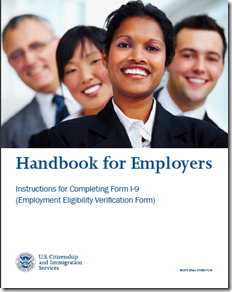This coming fall, the Department of Homeland Security may release its updated version of the Form I-9.
The new form is likely to be 80 percent larger than before, increasing from a five-page document to nine pages and will include several changes over the previous version. While some of the proposed (but not yet finalized) changes aim to improve the employee verification process, others can complicate the process.
Moreover, a few of the changes are even controversial.
Since failure to meet compliance with Form I-9 can result in audits and fines, it is imperative that employers understand the proposed changes, be ready to supply the necessary information, and are prepared to update training materials. It is more important than ever that employers are in full compliance with all regulations; U.S. Immigration and Customs Enforcement (ICE) reported five times as many audits in the last three years compared to 2008 and more than $9 million in fines for I-9 violations.
To better understand how the proposed new Form I-9 can improve or impede on the verification process, consider the good, the bad, and the potentially ugly proposed changes:
Positive changes on the way
Some of the proposed updates will provide clarification on some previously confusing fields. These changes aim to help employers and new hires properly provide the required information:
- The form itself has been expanded to two pages, and a new field on the top of Page 2 asks for the employee name, in case the pages get separated.
- Improvement in heading lines for the document fields clarify where List B and C information should be placed on the form.
- Perjury language has been repositioned and enumerated for clarification and readability to avoid any confusion.
- New language helps employers understand what documents are acceptable for non-immigrant aliens, and the cases in which a Social Security Card does not grant an individual permission for work.
Leaving room for error – and non-compliance
While some of the changes promise to facilitate more accurate completion of Form I-9, the new document also leaves and creates many gray areas, without clarification in the instructions, about what is required. These changes present new possibilities for errors and put employers at greater risk of receiving audits and fines.
For example:
- The field for the Social Security number has nine slots for each digit, which does not allow enough space for the employee to correct the information if entered incorrectly.
- The new form will ask for “the employee’s first day of work for pay.” This field raises some concern as the employee might not start on that date or the start date may be unknown at the time of hire. Does this mean the employer must update this field at a later date? (A better approach would be to ask for the employee’s anticipated or estimated first day of work for pay.)
- The “Updating and Reverification” section has been renamed “Reverification and Rehires.” This may cause confusion as to whether or not the section should be used when updating an employee’s name.
Larger areas of concern
While avoiding errors is of great importance for employers, especially as they seek to avoid the hefty fines that come along with an audit, there are also areas of the form that are causing greater public concern around privacy issues and processes:
- The new proposed form includes fields for an employee’s phone number and email address. Though these fields are optional, many feel that the DHS should not have this information, as it could be used to contact individuals directly to probe for potential employer violations.
- The U.S. Customs and Immigration Services has started the process of creating a new identification number for non-citizens to be used throughout the immigration process. Currently, the USCIS number and Alien number are the same; the addition of a new USCIS number may cause more confusion.
- The form also has an area designated for a 3-D barcode. Although the reason for this addition has not been explained, it raises concerns about around privacy and the government collecting employee data.
Although the new Form I-9 has not yet been finalized, some or all of the proposed changes may be going into effect over the next few months. In the meantime, the latest updates on the new form will be available on the TALX blog.
Employers who become familiar with the changes in advance will have a significant advantage and can reduce the chance of making a costly error once the changes are mandated. They can also avoid or minimize the rush to train HR and support staff on the new requirements during the busy Q4 hiring season.
To help ensure compliance with the new changes, companies can also benefit from partnering with third-party I-9 experts, who work closely with the government agencies and can help optimize the process. With the right preparation and education, employers can be confident that they are meeting requirements and avoiding the hefty fines that come with mistakes as they develop the workforces that will help them meet company goals.
